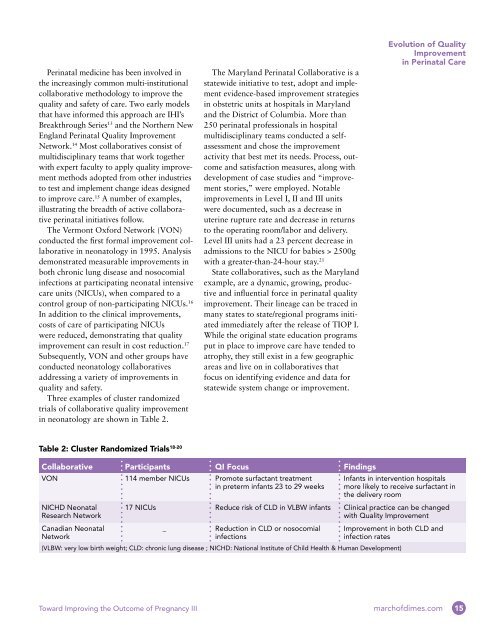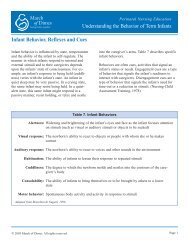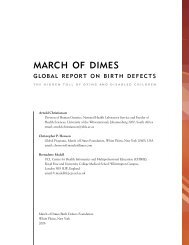Toward Improving the Outcome of Pregnancy III - March of Dimes
Toward Improving the Outcome of Pregnancy III - March of Dimes
Toward Improving the Outcome of Pregnancy III - March of Dimes
You also want an ePaper? Increase the reach of your titles
YUMPU automatically turns print PDFs into web optimized ePapers that Google loves.
Perinatal medicine has been involved in<br />
<strong>the</strong> increasingly common multi-institutional<br />
collaborative methodology to improve <strong>the</strong><br />
quality and safety <strong>of</strong> care. Two early models<br />
that have informed this approach are IHI’s<br />
Breakthrough Series 13 and <strong>the</strong> Nor<strong>the</strong>rn New<br />
England Perinatal Quality Improvement<br />
Network. 14 Most collaboratives consist <strong>of</strong><br />
multidisciplinary teams that work toge<strong>the</strong>r<br />
with expert faculty to apply quality improvement<br />
methods adopted from o<strong>the</strong>r industries<br />
to test and implement change ideas designed<br />
to improve care. 15 A number <strong>of</strong> examples,<br />
illustrating <strong>the</strong> breadth <strong>of</strong> active collaborative<br />
perinatal initiatives follow.<br />
The Vermont Oxford Network (VON)<br />
conducted <strong>the</strong> first formal improvement collaborative<br />
in neonatology in 1995. Analysis<br />
demonstrated measurable improvements in<br />
both chronic lung disease and nosocomial<br />
infections at participating neonatal intensive<br />
care units (NICUs), when compared to a<br />
control group <strong>of</strong> non-participating NICUs. 16<br />
In addition to <strong>the</strong> clinical improvements,<br />
costs <strong>of</strong> care <strong>of</strong> participating NICUs<br />
were reduced, demonstrating that quality<br />
improvement can result in cost reduction. 17<br />
Subsequently, VON and o<strong>the</strong>r groups have<br />
conducted neonatology collaboratives<br />
addressing a variety <strong>of</strong> improvements in<br />
quality and safety.<br />
Three examples <strong>of</strong> cluster randomized<br />
trials <strong>of</strong> collaborative quality improvement<br />
in neonatology are shown in Table 2.<br />
Table 2: Cluster Randomized Trials 18-20<br />
Collaborative<br />
VON<br />
NICHD Neonatal<br />
Research Network<br />
Canadian Neonatal<br />
Network<br />
Participants<br />
114 member NICUs<br />
17 NICUs<br />
_<br />
The Maryland Perinatal Collaborative is a<br />
statewide initiative to test, adopt and implement<br />
evidence-based improvement strategies<br />
in obstetric units at hospitals in Maryland<br />
and <strong>the</strong> District <strong>of</strong> Columbia. More than<br />
250 perinatal pr<strong>of</strong>essionals in hospital<br />
multidisciplinary teams conducted a selfassessment<br />
and chose <strong>the</strong> improvement<br />
activity that best met its needs. Process, outcome<br />
and satisfaction measures, along with<br />
development <strong>of</strong> case studies and “improvement<br />
stories,” were employed. Notable<br />
improvements in Level I, II and <strong>III</strong> units<br />
were documented, such as a decrease in<br />
uterine rupture rate and decrease in returns<br />
to <strong>the</strong> operating room/labor and delivery.<br />
Level <strong>III</strong> units had a 23 percent decrease in<br />
admissions to <strong>the</strong> NICU for babies > 2500g<br />
with a greater-than-24-hour stay. 21<br />
State collaboratives, such as <strong>the</strong> Maryland<br />
example, are a dynamic, growing, productive<br />
and influential force in perinatal quality<br />
improvement. Their lineage can be traced in<br />
many states to state/regional programs initiated<br />
immediately after <strong>the</strong> release <strong>of</strong> TIOP I.<br />
While <strong>the</strong> original state education programs<br />
put in place to improve care have tended to<br />
atrophy, <strong>the</strong>y still exist in a few geographic<br />
areas and live on in collaboratives that<br />
focus on identifying evidence and data for<br />
statewide system change or improvement.<br />
QI Focus<br />
Promote surfactant treatment<br />
in preterm infants 23 to 29 weeks<br />
Reduce risk <strong>of</strong> CLD in VLBW infants<br />
Reduction in CLD or nosocomial<br />
infections<br />
Evolution <strong>of</strong> Quality<br />
Improvement<br />
in Perinatal Care<br />
Findings<br />
Infants in intervention hospitals<br />
more likely to receive surfactant in<br />
<strong>the</strong> delivery room<br />
Clinical practice can be changed<br />
with Quality Improvement<br />
Improvement in both CLD and<br />
infection rates<br />
(VLBW: very low birth weight; CLD: chronic lung disease ; NICHD: National Institute <strong>of</strong> Child Health & Human Development)<br />
<strong>Toward</strong> <strong>Improving</strong> <strong>the</strong> <strong>Outcome</strong> <strong>of</strong> <strong>Pregnancy</strong> <strong>III</strong> march<strong>of</strong>dimes.com<br />
15

















